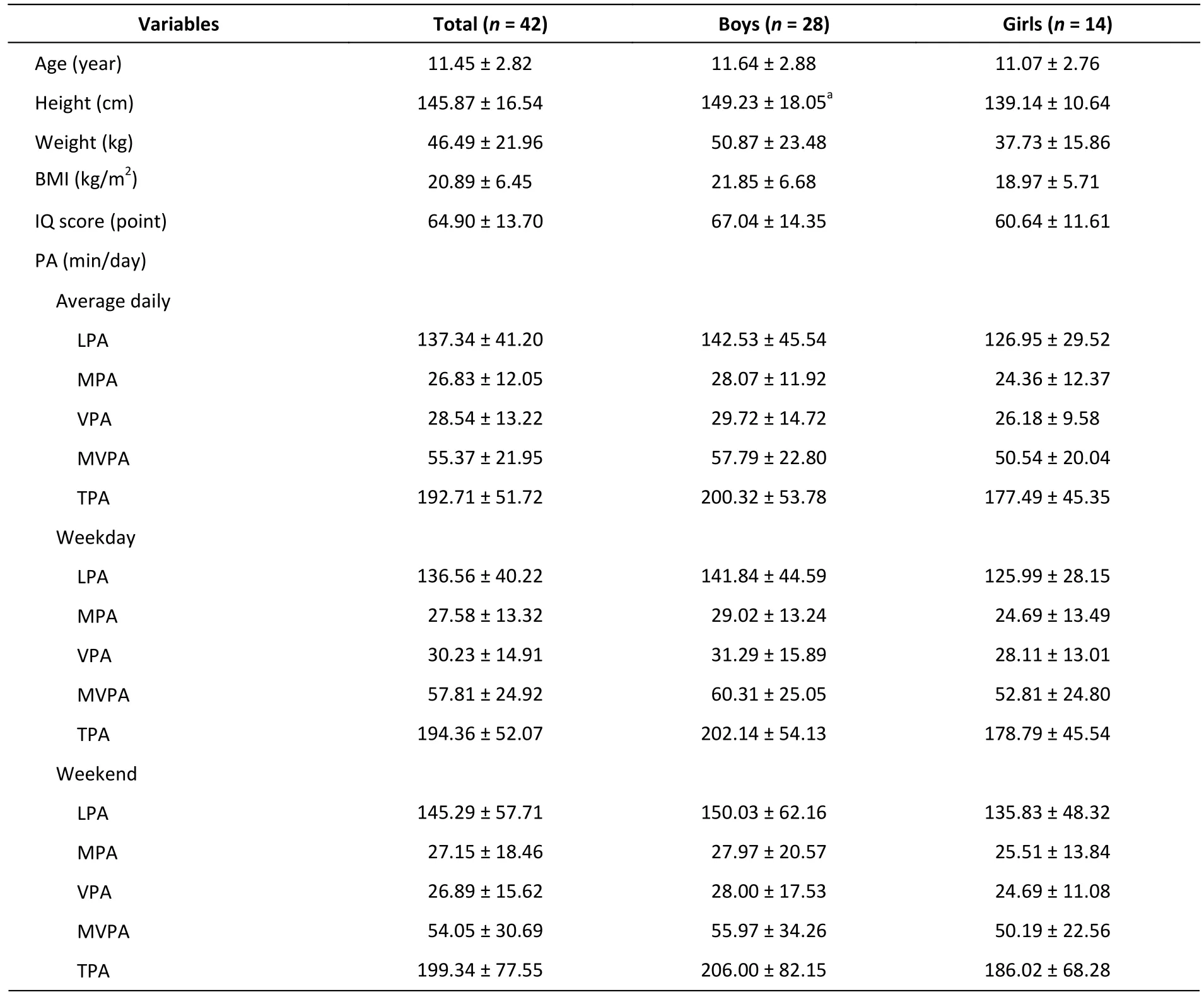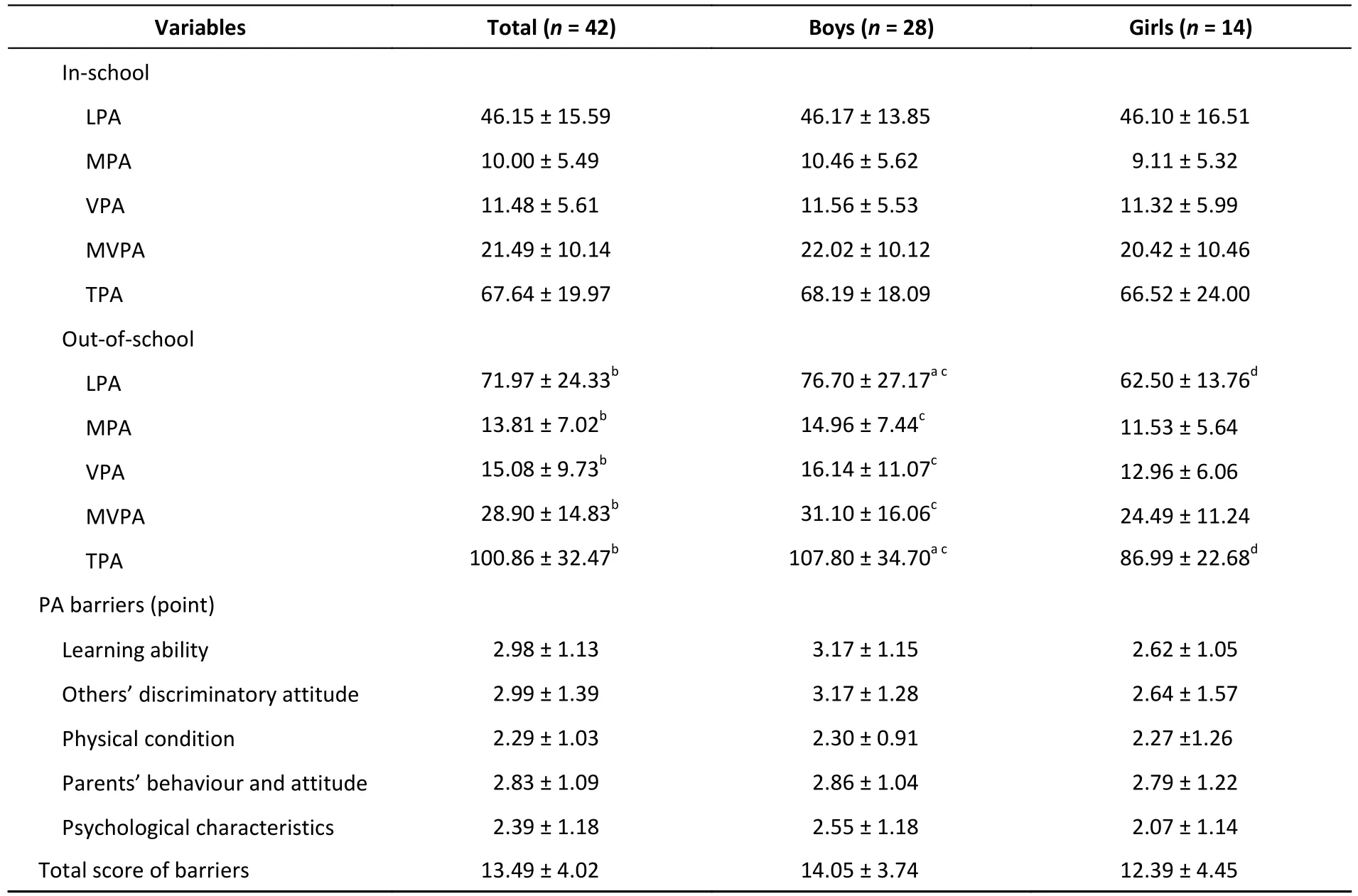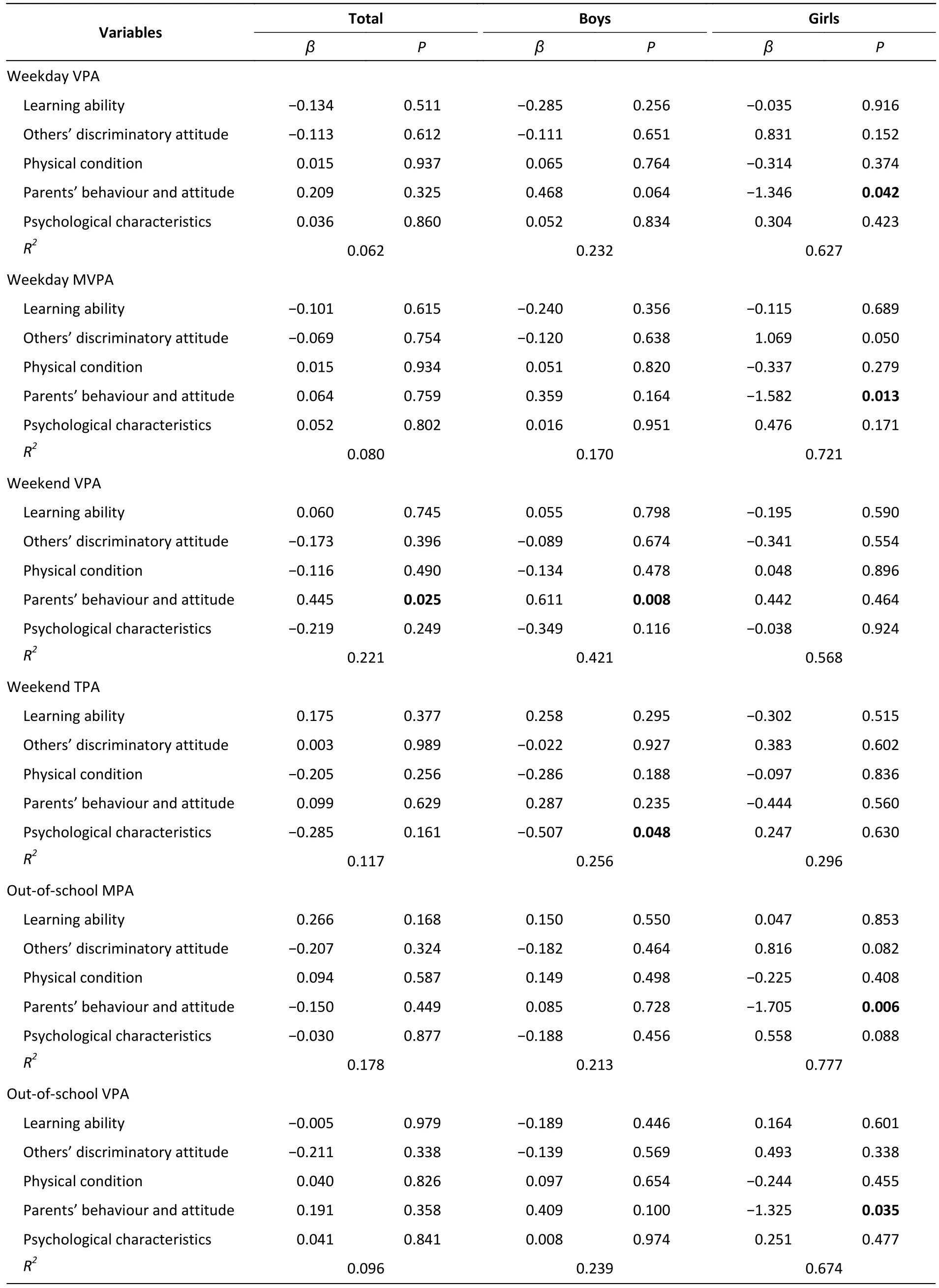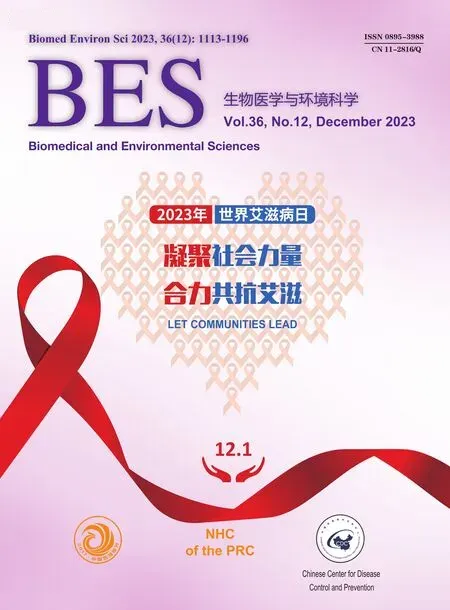Barriers to Physical Activity among Children and Adolescents with lntellectual Disabilities: A Cross-sectional Study*
WANG Yu, JIN Qiu Meng, WANG Chao, HE Gang, LI Dong Sheng, and MA Kai Yue
Regular physical activity (PA) has numerous advantages in improving the physical and mental health of children and adolescents[1].However, the PA status quo for children and adolescents with intellectual disabilities (ID) is dismal.Children and adolescents with ID frequently exhibit sedentary behaviors because their physical, sensory, and/or cognitive impairments make it difficult to participate in sports and games with their peers[2].They have higher rates of mental illness, obesity, type 2 diabetes, and other health problems than peers with typical development (TD).
PA interventions can reduce the risk of chronic diseases in children and adolescents while improving their lifestyles.However, a recent systematic review and meta-analysis revealed that interventions designed for children and adolescents with TD are ineffective in improving the PA of children and adolescents with ID[3], possibly because they encounter more barriers to PA than children and adolescents with TD.
To ensure the effectiveness of PA interventions,researchers must develop interventions based on a broad understanding of PA and its barriers.Many studies have investigated the factors that prevent children and adolescents with ID from participating in PA.However, recent reviews have revealed that the existing information is limited and uncertain[4],implying that more research into the factors influencing engagement in physical exercise is required[2].In China, many children and adolescents have ID, but research on the barriers to PA in this population is scarce.Therefore, we aimed to explore the barriers to PA among Chinese children and adolescents with ID.
This study employed a cross-sectional design.Sixty children and adolescents aged 8-18 years with mild to moderate ID were recruited from special education schools in Beijing and Qinhuangdao,China, and assessed following parental consent.The intelligence level of the participants was assessed by two researchers who had received training in psychological measurements to correctly perform the Combined Raven’s Test based on the PsyKey Psychometric System according to the prescribed procedures.The inclusion criteria were as follows:(1) mild to moderate ID rating, that is, IQ score between 55 and 89; (2) ability to understand the test content and follow simple instructions; and (3) no evident physical disabilities and ability to perform regular PA.This study was approved by the Ethics Committee of the Capital University of Physical Education and Sports (Ethical Approval No.:2020A13).The study protocol was in accordance with the Declaration of Helsinki and informed consent was obtained from all participants and their parents.
The variables included age, height, body weight,body mass index (BMI), IQ score, PA time, and barriers to PA.The ActiGraphGT3X+ accelerometer(ActiGraph, LLC, Pensacola, FL) was used to measure the participants’ PA.Actilife version 6.13.3 was used to download and analyze the data.Raw data were captured at a sampling interval of 1 s based on the PA intensity cut-off points developed by Zhu et al.[5].Validated intensity cut-off points were 100–2,800 counts per minute (cpm) for light PA (LPA),2,800–4,000 cpm for moderate PA (MPA), and ≥4,000 cpm for vigorous PA (VPA).Since barriers to PA may vary across different timeslots and places, PA data were reported as average daily, weekday,weekend, in-school, and out-of-school data after processing.
Barriers to participants’ PA were reported by their parents, who completed the “Questionnaire on Barriers to Physical Activity of Children and Adolescents with Intellectual Disabilities.” This questionnaire uses a Likert 5-point scale to evaluate all questions, which are divided into five parts.With 2-4 questions in each part and 5 options in each question, i.e., “totally disagree-totally agree,”representing 1-5 points, respectively.The score for each part was the average score for all questions within this part.Questions in the five parts were all reverse assigned; the higher the score, the worse the performance in this part.The questionnaire was developed by our team based on previous studies.The specific formation process, reliability, and validity of the test results have been presented elsewhere.
The Statistical Package for the Social Sciences Version 20.0 (IBM Corp., Armonk, NY, USA) was used for data analysis.Descriptive statistics were expressed in mean ± standard deviation (SD).Multivariate linear regression analysis was used to determine barriers to PA among children and adolescents with ID, with PA as dependent variables and the scores of the five questionnaire parts as independent variables controlling for age and BMI.The significance level was set atP< 0.05.
The final valid sample consisted of 42 children and adolescents with mild to moderate ID (mean age: 11.45 ± 2.82 years, 66.67% boys) (Table 1).
Table 2 presents the regression analysis results of PA and their barriers.We only reported models with significant results.“Parents’ behaviour and attitude” was positively associated with overall participants’ weekend VPA, boys’ average daily VPA,and weekend VPA.However, it was negatively associated with girls’ weekday MPA, VPA, and MVPA(moderate-to-vigorous PA), and out-of-school MPA,VPA, and MVPA.This indicates that “parental behavior and attitude” may hinder girls’ PA, but not necessarily for boys.This could be related to thepsychological differences between boys and girls,with boys being more energetic and risk-taking than girls, resulting in differing reactions to their parents’attitudes.Previous research has found similar sexbased differences[6].Parents play an important role as “gatekeepers” in the PA behavior of children and adolescents with TD[7].This role of parents or other relatives is particularly important because individuals with ID face additional barriers to PA, and parental advocacy is critical to educating others about a child’s ability, providing support to others, finding additional activity opportunities, and ensuring the safety of child activities.Conversely, parents’ distrust of their child’s ability and overprotection may act as barriers to PA for the mentally disabled community due to the child’s identity as mentally disabled[8].

Table 1.Participants’ characteristics (mean ± SD)

Continued

Table 2.Results of regression analysis of PA and their barriers for participants

Continued

Continued
“Psychological characteristics” are negatively associated with boys’ weekend TPA.Generating a sense of pleasure in PA can increase the motivation to participate in more PA, and subjectively perceived benefits and barriers to PA can significantly impact participants’ participation in PA[9].In addition,promoting activity and positive experiences from an early age facilitates future activity, whereas early negative experiences may be a barrier to PA in adolescents with ID[10].
“Others’ discriminatory attitude” was positively associated with girls’ weekday MPA.This suggests that the discriminatory attitudes of others may encourage children and adolescents with ID to participate in PA.This anomalous result may be due to the specificity of the group of adolescents with ID,the insufficient effective sample size of the two schools, and PA, which may have resulted in random results in the data after a more detailed classification.Future studies could, therefore,attempt to increase the sample size and collect more comprehensive factors to improve the generalizability of the results.
This is one of the few empirical studies to use a combination of direct and indirect measures to investigate barriers to PA in Chinese children and adolescents with ID.In conclusion, the barriers to PA reported in this study for boys with mild to moderate ID may be psychological characteristics,whereas for girls, they may be parental behavior and attitude.Given the limited sample and crosssectional design of this study, research with larger sample and more robust design is needed to provide stronger evidence on barriers of PA in the young ID group.
AcknowledgmentsNone.
Conflicts of InterestThe authors declare no conflict of interest.
&These authors contributed equally to this work.
#Correspondence should be addressed to WANG Chao, PhD, Associate Professor, Tel: 86-10-82099206, Email: wangchao@cupes.edu.cn
Biographical notes of the first authors: WANG Yu,male, born in 1991, MD, majoring in the physical activity of children; JIN Qiu Meng, female, born in 1993, MD,majoring in the physical activity of children.
Received: June 5, 2023;
Accepted: August 25, 2023
 Biomedical and Environmental Sciences2023年12期
Biomedical and Environmental Sciences2023年12期
- Biomedical and Environmental Sciences的其它文章
- World Flu Day: Protecting Health, Keeping away from Flu Troubles
- World AIDS Day: Mobilizing Social Forces to Fight AIDS Together
- Radiation Exposure for Patients and Staff during Different lnterventional Procedures Using Anthropomorphic Phantoms:A Complete Evaluation of Different Body Regions*
- Adipocytokine Gene SNPs and Type 2 Diabetes in Mongolians:A Gene-Gene and Gene-Environment lnteraction Study*
- A Cascade Analysis of Community Transmission Risks for HIV among People Who Inject Drugs Living with HIV in Iran
- The Pathogenic Characteristics of the lnitial Three Mpox Cases in Hunan Province, China*
